| Author |
Message |
Glen A Cleeton

|
 Posted: Wed 09 Mar, 2011 4:41 pm Post subject: Posted: Wed 09 Mar, 2011 4:41 pm Post subject: |
 |
|
I think I like a lot of the sword bayonets as well and was just yesterday considering a "late" 1870 rolling block double edged blade. There have been a few Brunswicks as well I have almost adopted.
It dawned on me in seeing page two again today that I could easily like a bunch of these. A great show from all and many of western histories represented. always another to catch my eye.
Here is one I'll only have in pictures unless it is an attic I visit in time.
The Roby bowies
Cheers
GC
text for that portrait
"Great CDV Portrait of a Federal Infantryman, Probably 44th Mass. Inf., With ID on Verso but Difficult to Discern. Wears shell jacket with Enfield ctg. Box and sling and waist belt with snake buckle. A large eagle pommel Roby Bowie knife is tucked in the front of his belt. Holds Enfield rifled musket with bayonet fixed. Military backdrop and American flag on the table at his side. Appears to be a period copy of a tintype. Backmark of "Miller 58 Main Street Charlestown" (Mass.) Very fine quality and condition, possibly slightly trimmed along the top edge but detracts nothing from the image. Important image providing a context for the use of these rare knives."
 Attachment: 8.33 KB Attachment: 8.33 KB

 Attachment: 8.54 KB Attachment: 8.54 KB

 Attachment: 10.47 KB Attachment: 10.47 KB

 Attachment: 139.26 KB Attachment: 139.26 KB
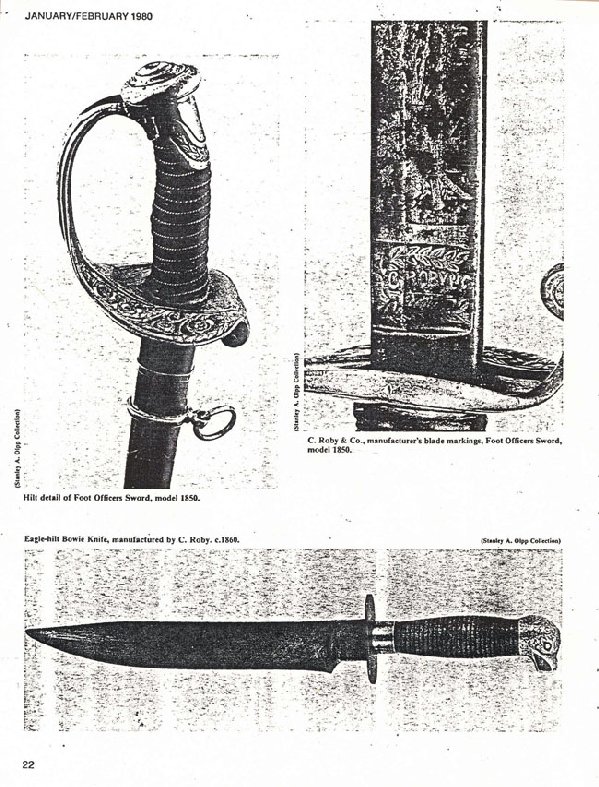
 Attachment: 162.59 KB Attachment: 162.59 KB
[ Download ]
|
|
  |
 |
|
Jonathan Hopkins
|
 Posted: Mon 04 Apr, 2011 6:47 pm Post subject: Posted: Mon 04 Apr, 2011 6:47 pm Post subject: |
 |
|
Here is another British Pattern 1845 Infantry Officer's Sword. This one was made by Charles Reeves--probably in the 1850s--and retailed by Phillips & Co. in the 1870s. This sword features Reeves' patent hilt construction, meaning that the tang is the same width as the grip. The grip slabs are pressed leather and the exposed tang can be seen in the photos below. This is "the real fighting stuff" and not a dress sword.


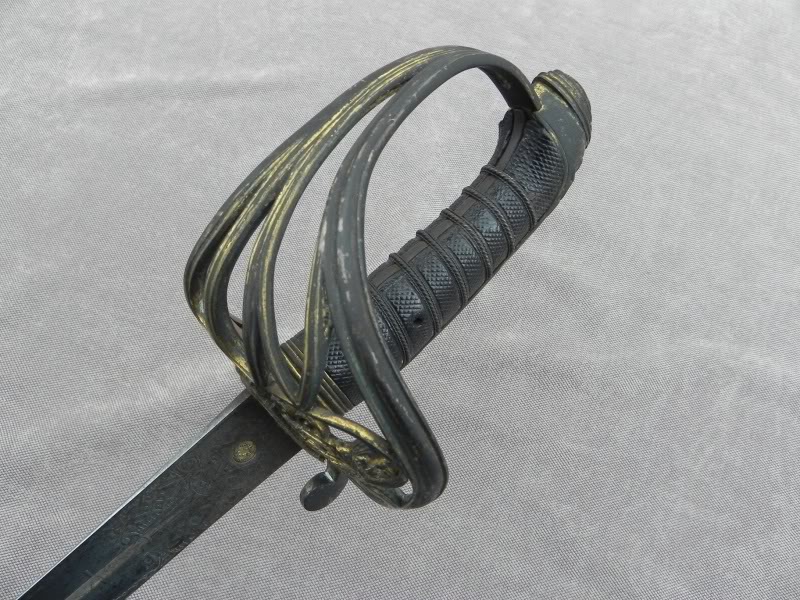

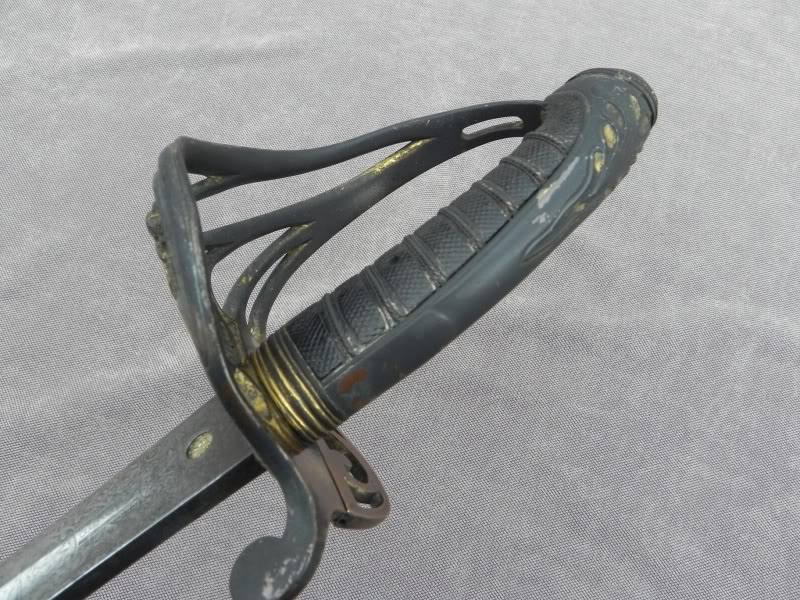

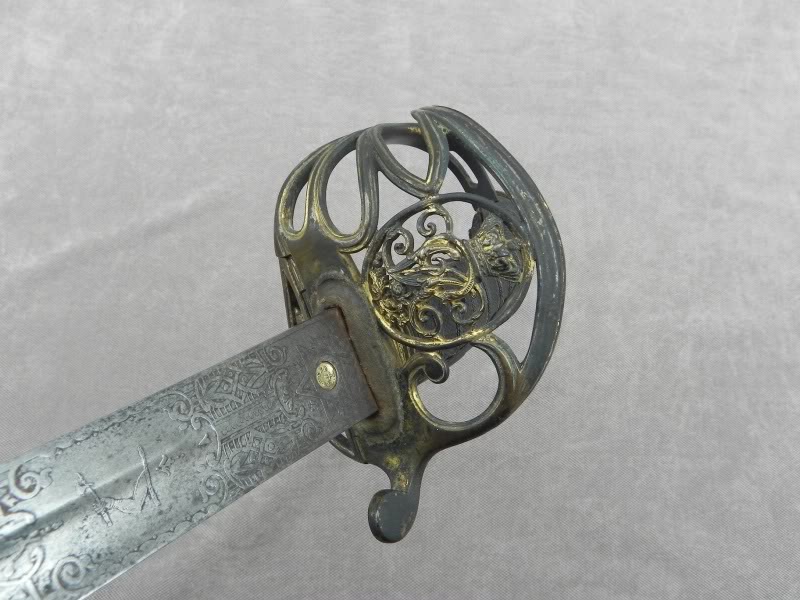

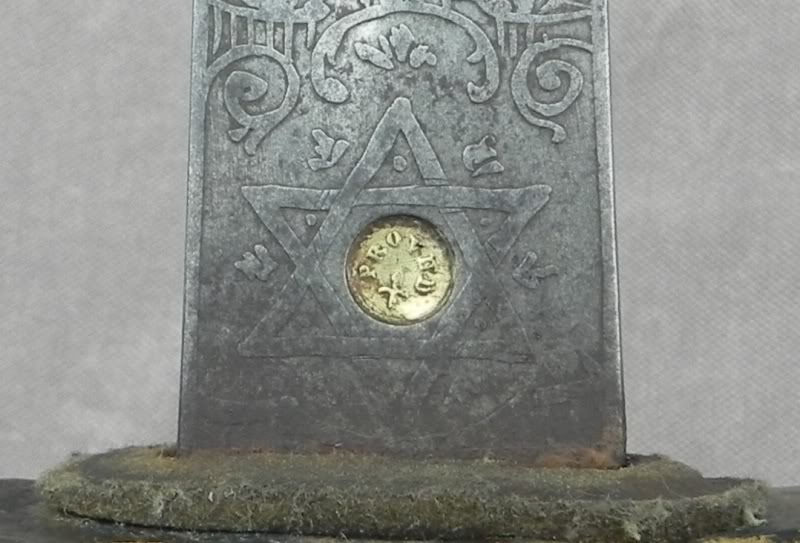
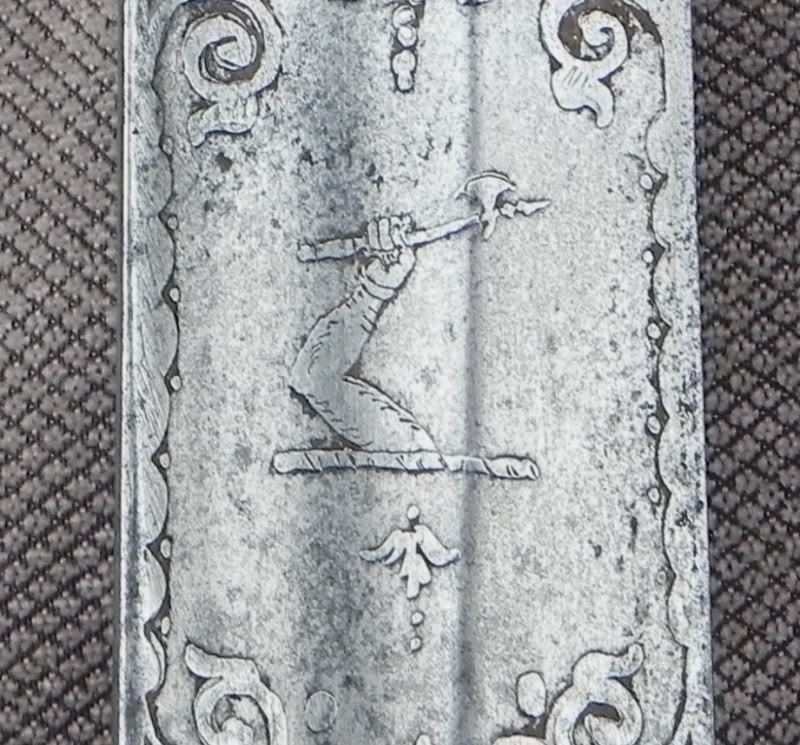


|
|
  |
 |
|
Bryan Johnson
|
 Posted: Fri 13 May, 2011 5:37 pm Post subject: Two Model 1850 Foot Officers Sabers Posted: Fri 13 May, 2011 5:37 pm Post subject: Two Model 1850 Foot Officers Sabers |
 |
|
I really enjoy the Victorian British Sabers. I may have to look into a few. I thought folks might enjoy these two swords from the mid-1800s. The first is a M1850 Ames Foot Officers Presentation to LT John MacKenzie (unfortunately I haven't been able to find him definitively in records). The scabbard has a break towards the drag the was repaired (with all things) electrical tape. I haven't had time to have it worked on so I've left it. The blade however is gorgeous with at least 80% of its frosting left.
The second is a Non-Regulation M1850 Foot manufactured by Klingenthal. This is more of a high grade model that the ones made by Klingenthal for the American marked that followed the regulation style.
[/img]
 Attachment: 65.39 KB Attachment: 65.39 KB
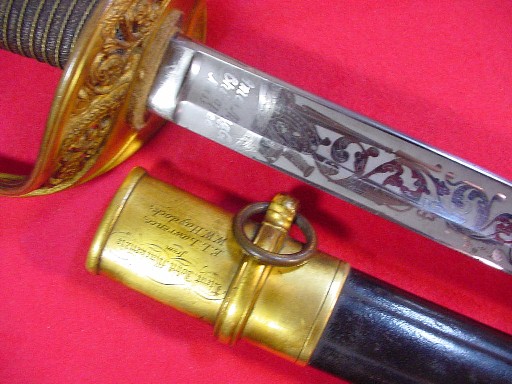
AMES M1850 Foot Officers
 Attachment: 51.83 KB Attachment: 51.83 KB
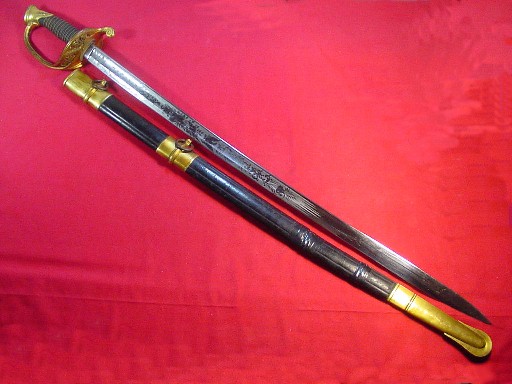
AMES Model 1850 Foot Officers 2
 Attachment: 58.48 KB Attachment: 58.48 KB
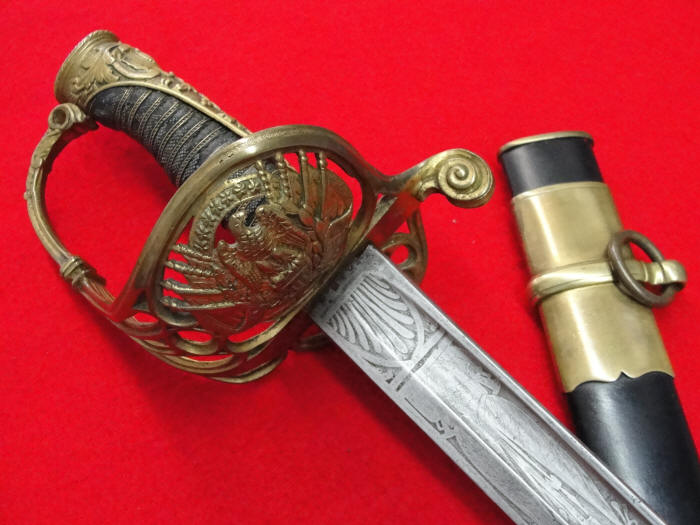
Non Reg Klingenthal M1850
 Attachment: 58.05 KB Attachment: 58.05 KB
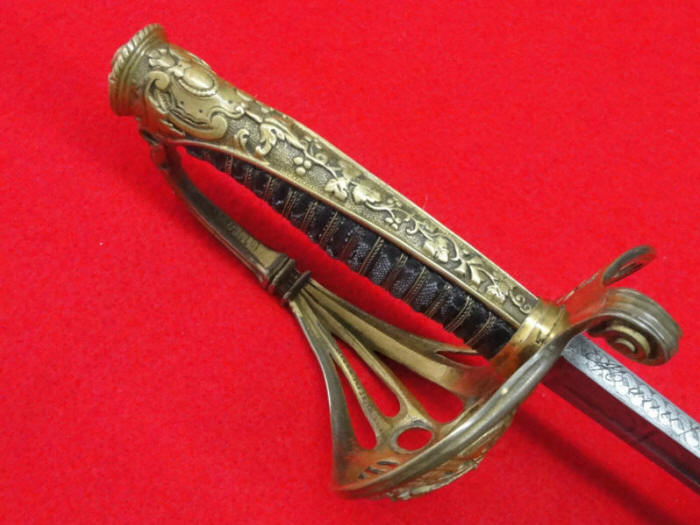
Klingenthal Hilt
 Attachment: 53.65 KB Attachment: 53.65 KB
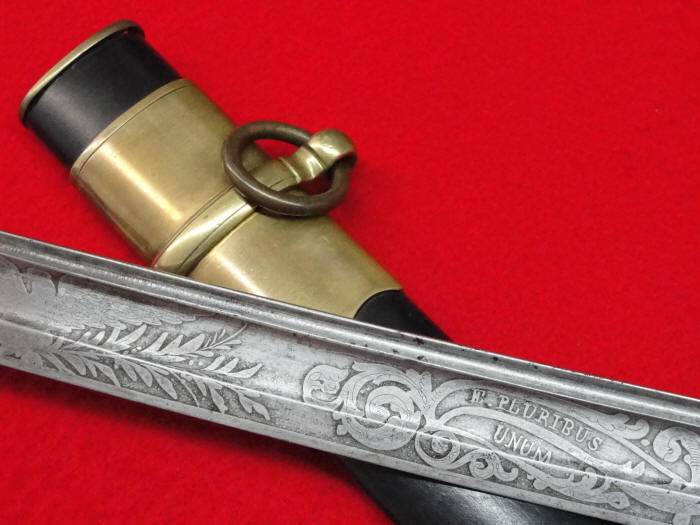
Klingenthal Blade Etching
 Attachment: 44.01 KB Attachment: 44.01 KB
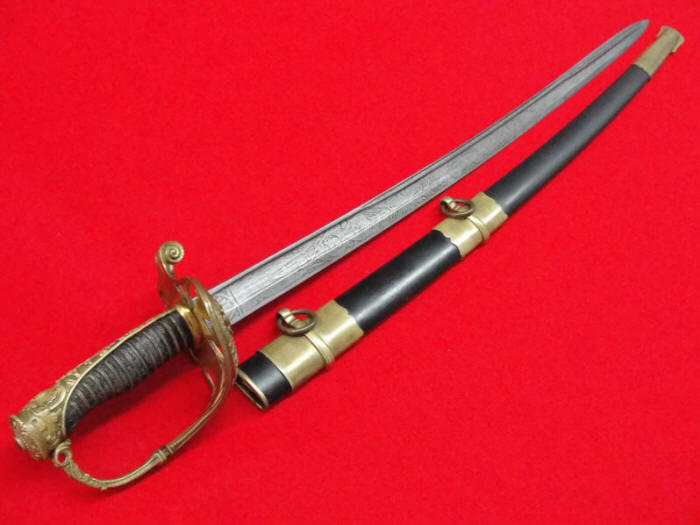
M1850 Non-Regulation Foot Officers Sword Klingenthal
Bryan Johnson
|
|
  |
 |
Glen A Cleeton

|
 Posted: Fri 13 May, 2011 7:00 pm Post subject: Posted: Fri 13 May, 2011 7:00 pm Post subject: |
 |
|
Nice swords Bryan.
The presentation sword is probably searchable and I'm thinking maybe an nco raised to Lt in the filed. The 79th New York Infantry saw a lot of action and the surname sure fits. The folks at http://civilwartalk.com/ are really good at finding the individuals.
The French made U.S. etched blade can be pretty amazing. I am trying to attach a large file and it may be too big (tall) for that. I passed on this one a year or so ago as other things were pending but it is an excellent example of a foreign made U.S. etched blade. No imperial looking eagle in the guard of this one but the blade is amazing.
http://files.myopera.com/3sails/albums/393952...149181.jpg
http://files.myopera.com/3sails/albums/3939522/liberty.jpg
Cheers
GC
|
|
  |
 |
|
Bryan Johnson
|
 Posted: Sat 14 May, 2011 2:59 pm Post subject: Sword Bayonet Posted: Sat 14 May, 2011 2:59 pm Post subject: Sword Bayonet |
 |
|
One of the posts showed a 2nd Model Baker Sword Bayonet. Attached are a couple of shots of an original. Sorry for the poor quality of the photos they are all I have at this time.
 Attachment: 56.99 KB Attachment: 56.99 KB
[ Download ]
 Attachment: 47.28 KB Attachment: 47.28 KB
[ Download ]
Bryan Johnson
|
|
  |
 |
|
Jonathan Hopkins
|
 Posted: Fri 27 May, 2011 7:14 pm Post subject: Posted: Fri 27 May, 2011 7:14 pm Post subject: |
 |
|
The Pattern 1895 Infantry Officer's Sword was introduced 1896 following the introduction of a new blade in 1892. The Pattern 1892 blade was a radical departure from the previous cut and thrust blade of the Pattern 1845/1854 Infantry Officer's Sword. The P1892 blade is a wicked thrusting blade that has a dumbbell cross section for just over half of its length. The plated steel bowl guard of the P1895 offered superior protection compared to its predecessors and was to have either a 5 inch or 5 1/2" grip, depending on the size of the officer's hand. The 1896 order called for officers to re-hilt or replace their swords. Not all officers had adopted the P1892 blade when it was introduced, therefore some P1895s have the older P1845/1854 blades and others have the newer P1892 blades.
1) This Pattern 1895 Infantry Officer’s Sword was made by Henry Wilkinson. The sword was made and purchased in 1888. At the time of sale it would have been a Pattern 1854 Infantry Officer’s Sword with brass “Gothic” hilt. The sword would have been sent back to Wilkinson in 1896 to be re-hilted. The steel guard is stamped “STEEL HILT”, which is a stamp exclusive to P1895s by Wilkinson and demonstrates that they were responsible for refitting the sword. The brown leather service scabbard has a wood core (Obeche, a West African hardwood) and has a brass alloy throat and chape. The original owner served in numerous campaigns and expeditions including the Niger-Sudan Campaign 1897, Tirah Expedition 1897, Waziristan 1902, Younghusband's Expedition into Tibet 1904, and was KIA in France in September, 1915.

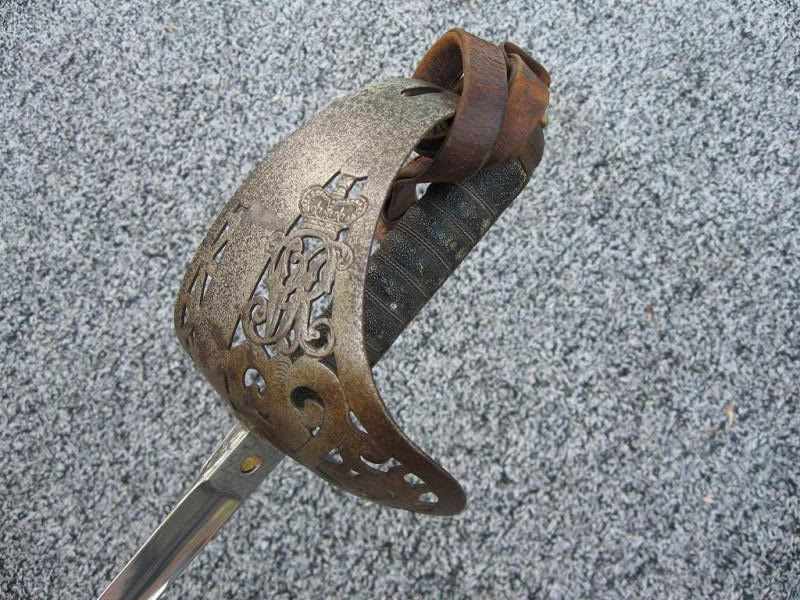
2) This Pattern 1895 Infantry Officer's Sword is by Henry Wilkinson, Pall Mall, London. The guard is nickel plated steel on the outer portion, and blued steel on the inner portion (meaning the area facing the hand). The sharp 34 inch blade is still quite bright with areas of minor pitting, and is nicely etched with floral motifs, crowned VR cyphers, and the owner's initials; AJFR. The sword has a nickel plated steel scabbard. The entry from the Wilkinson ledger states that the sword was a regulation infantry sword purchased in 1876. Originally the sword would have been a Pattern 1854 Infantry Officer's Sword with brass "Gothic" hilt. In 1896 the blade was re-hilted with the newest regulation hilt--the Pattern 1895. The original owner of this sword was a career officer who served in the British Army and Bengal Army from 1867 to 1906, rising to Major-General and serving in numerous campaigns and expeditions--2nd Anglo-Afghan War 1878-80 (wounded), Hazara Expedition 1888, 1st and 2nd Miranzai Expeditions 1895, Relief of Chitral 1895, Risings of the North West Frontier 1897-98, and the Boxer Rebellion 1900.


|
|
  |
 |
|
Jonathan Hopkins
|
 Posted: Sat 28 May, 2011 1:45 pm Post subject: Posted: Sat 28 May, 2011 1:45 pm Post subject: |
 |
|
The Pattern 1897 Infantry Officer's Sword was not an entirely new pattern. The P1897 is the same sword with some minor cosmetic modifications--the inner edge of the guard is turned down and the piercings on the guard are smaller.
1) This Pattern 1897 Infantry Officer’s Sword made by Wilkinson in 1898 features a “Patent Solid Hilt”, and was quite an expensive sword in its day. This means that the tang is the full width of the grip, which enhances the strength of the hilt and, in my opinion, improves the balance of the sword—both tremendous benefits for a fighting sword. The blade is etched with the owner’s monogram (WHW), scrolling foliage and VR ciphers. The steel hilt is nickel plated and also features a VR cipher. The grip slabs are rosewood. The brown leather field service scabbard is in excellent condition.
The original owner of the sword served in the Boer War, minor campaigns in West Africa, and WWI (he was a POW from 1914-18).

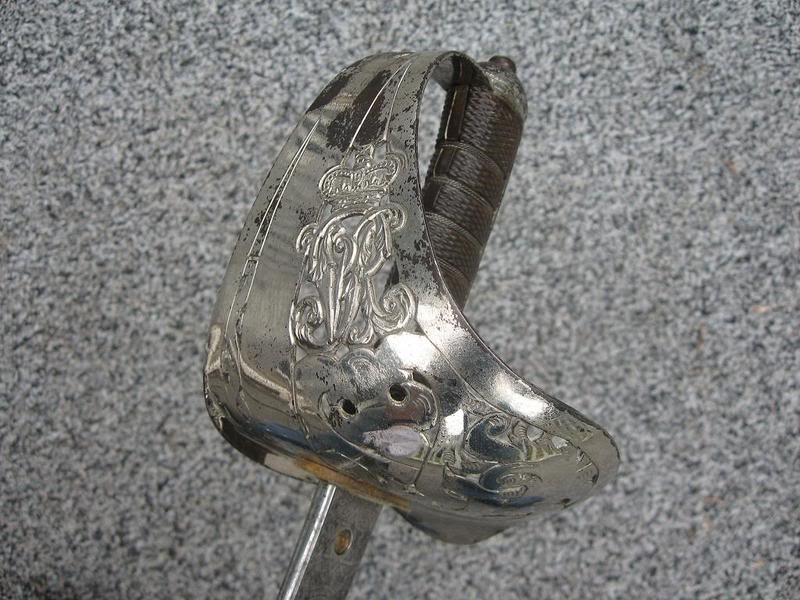
2) This example was made by Wilkinson 8 October 1906. What initially attracted me to this sword is that it is a rather late example of a Patent Solid Hilt, and I had been looking to add an Edwardian sword to my collection. The sword came to me with active rust, but with a little elbow grease (and by elbow grease I mean Nevr-Dull) the sword cleaned up nicely. The steel hilt with ERVII monogram has lost most of its plating, and the grip wire is completely gone. The missing wire shows that the grip slabs were riveted to the tang like the cavalry trooper's swords of the Victorian period. The steel scabbard has most of its plating still intact, but there is quite a lot of bubbling. The blade, while not in its original polish, is clean and in quite good condition considering the overall condition of the sword when it arrived. The blade has all the standard etchings as well as the owner's monogram DMK.
This officer had a successful career which spanned the years 1906-1944. He served with distinction during WWI earning the DSO with clasp, the MC, and was mentioned in despatches several times. He served as a staff officer with the 5th Australian Division in Egypt and Gallipoli, and with the British Army in France and Flanders.

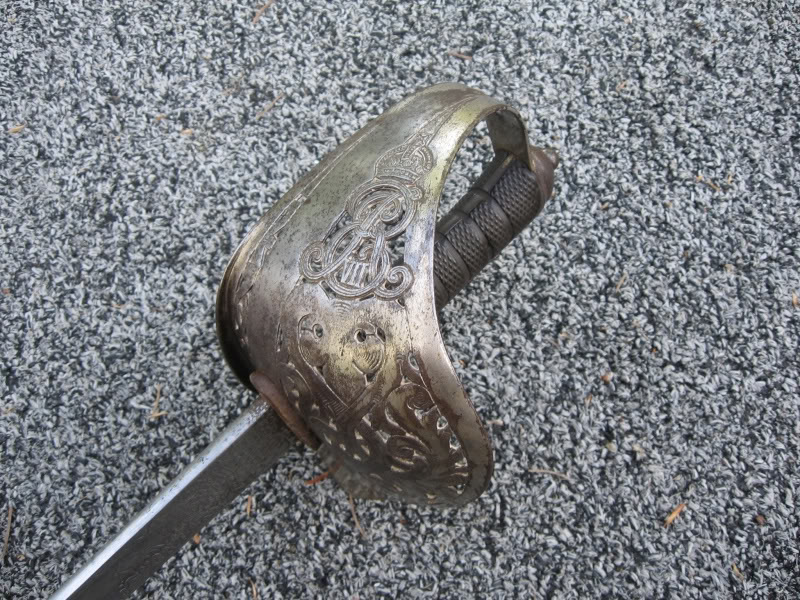
|
|
  |
 |
|
Jonathan Hopkins
|
 Posted: Sun 29 May, 2011 7:03 pm Post subject: Posted: Sun 29 May, 2011 7:03 pm Post subject: |
 |
|
Since the Napoleonic Wars officers of the Royal Artillery carried the same regulation patterns that were required of infantry officers, while their counterparts in the Royal Horse Artillery carried the regulation patterns worn by light cavalry officers. Brian Robson (Swords of the British Army, 1996) states that at some undetermined point in the late 1840s, officers in RA gave up carrying the infantry pattern sword in favor of Pattern 1821 Light Cavalry officer's sword. Robson tries to pinpoint a date for this change by examining portraiture of the period, and determines that this change probably occurred in 1846-47. The Dress Regulations of 1857 describe the the sword for all artillery officers as "Regulation, Light Cavalry". To this day the Pattern 1821 is the regulation pattern for officers of the Royal Artillery.
1) This 1821 Pattern Artillery Officer's sword was supplied by Phillips & Son, George Street, Hanover Square, London. This would date it between 1864-1875 (according to Bezdek's Swords and Sword Makers of England and Scotland). The blade, still in its original polish, bears the initials FFD and is decorated with scrolling foliage, the device of the Royal Artillery, cannon, and VR cypher (for Queen Victoria). The fish skin grip has shrunk and has browned with age. The brown leather field service scabbard is probably not the sword's original scabbard, but was probably purchased prior to the officer embarking for the Boer War.
The original owner was a career officer and served from 1863-1901, and he was stationed throughout the empire during these years. However, his only active service did not occur until the Boer War.


2) Made by Wilkinson in 1901, it features the "Patent Solid Hilt" which was favored by many officers who expected to see active service in some corner of the empire. It also has a long (still sharp!) cavalry length blade which bears standard etched decorations including scrolling foliage, the symbols of the Royal Artillery, Wilkinson's label and proof disc, etc., as well as the owner's initials--DRM--and his crest. he sword is in good condition. The hilt is especially fine and the blade has some minor pitting.
The officer who owned this sword served from 1903-1930 and was a decorated soldier. He earned two gallantry awards including the Military Cross (MS) and Distinguished Service Order (DSO).

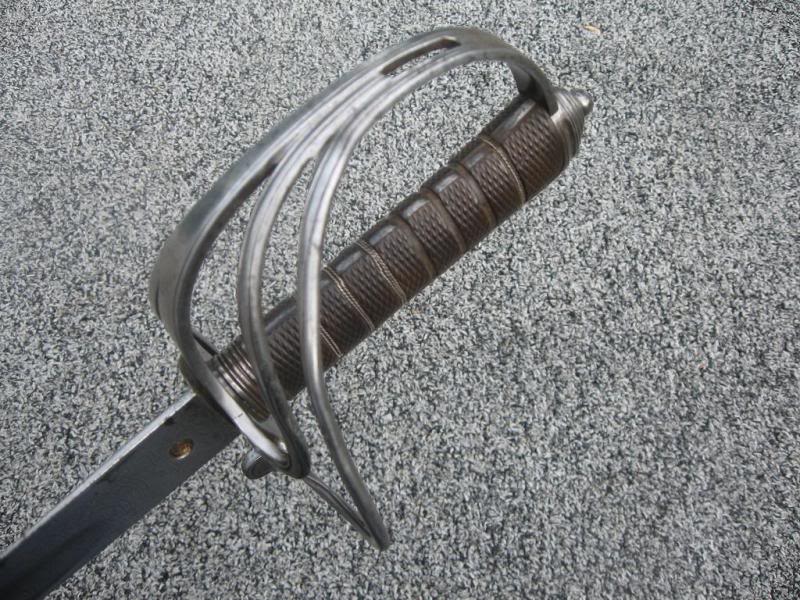
|
|
  |
 |
|
Bryan Johnson
|
 Posted: Thu 01 Sep, 2011 3:00 pm Post subject: American Sabers Posted: Thu 01 Sep, 2011 3:00 pm Post subject: American Sabers |
 |
|
Some American sabers from the mid 1800s. Took these home on leave and forgot to take a picture of the Klingenthal blade. Someone had actually coated it in shelac to preserve it, came off nicely though.
 Attachment: 28.31 KB Attachment: 28.31 KB
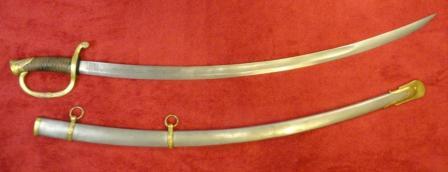
1840 Mounted Artillery Officer Saber
 Attachment: 25.36 KB Attachment: 25.36 KB

M1850 Staff & Field by Klingenthal
 Attachment: 46.66 KB Attachment: 46.66 KB
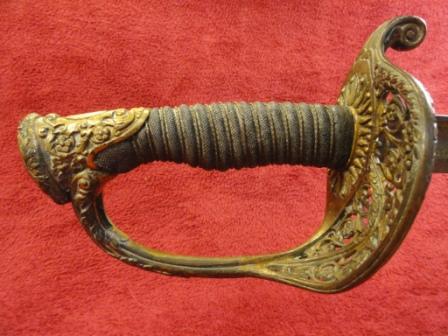
Hilt of Klingenthal
Bryan Johnson
|
|
  |
 |
|
Bryan Johnson
|
 Posted: Thu 01 Sep, 2011 3:10 pm Post subject: A couple of European Sabers from the collection Posted: Thu 01 Sep, 2011 3:10 pm Post subject: A couple of European Sabers from the collection |
 |
|
A M1829 French Mounted Artillery and a Weyersberg, Kirschbaum & Cie circa 1880s.
 Attachment: 27.45 KB Attachment: 27.45 KB

Weyersberg, Kirschbaum & Cie circa 1880s
 Attachment: 27.73 KB Attachment: 27.73 KB

M1829 French Mounted Artillery
Bryan Johnson
|
|
  |
 |
Glen A Cleeton

|
 Posted: Sat 03 Sep, 2011 8:57 am Post subject: Posted: Sat 03 Sep, 2011 8:57 am Post subject: |
 |
|
Thanks Bryan for sharing more pictures of the foot sword and artillery example. The late WKC French 1822 type is an outstanding reminder how long the sword type was manufactured. I had seen a very late American dealer Horstmann marking an example of the late WKC cavalry swords. This was in the 1880s-1890s as well. While bpth the light 1860s cavalry sword and the later 1872s seem to have survived in more numbers, there was obviously a market for the bigger swords.
One bit of a puzzle for me this past season has been regarding a lot of Bavarian history and a few specific sword forms. What is generically labeled as 1837 Austrian, a subset of preference and decoration seems to have arisen. Too many Maximilian (as a name) at first had confounded a lot of research, mostly because I was/am so ignorant of the politics and lineage. What had prompted me was a particular sword that circulated for a time and then came home here. A rather plain sword in most regards, the langets perked up my curiosity.
Hmm and ho I wondered, as I had seen this somewhere before. Of other examples of these, I started findy first Ludwig of Bavaria being followed by Maximilian of Bavaria.



Now, the story in my mind and searches, I find another Maximilian of the period, Prinz zu Wied. This fellow had followed some of Lewis&Clark's trails after first having spent time in South America. Too much to type as my own notes. A great start regarding his exploits can be found here.
http://faculty.evansville.edu/ck6/bstud/princemax.html
What had struck me as a bit unique about the following example I brought in was that the blade itself had been etched with the sunflower attributed to the Prinz zu Wied. Quite similar to the prairies Jerusalem Artichoke, the less meaty rooted sunflower has forever been named Helianthus maximilianii. Also etched on the blade is the crown and monogram for Maximilian of Bavaria, so we can place it in time and context to the above swords. Not to confuse things further, we can regard Mad Max and the short ruled Emperor of Mexico another time.  I have been getting pretty dizzy trying to learn more about politics and goings on in Europe during the 1848 to 1864 period. I have been getting pretty dizzy trying to learn more about politics and goings on in Europe during the 1848 to 1864 period.




So, long inquiry short; I am wondering if these sunflower langets (one on the bay now) and more specifically this one decorated with the bloom itself might be proprietary traits of the Neuwied locality itself as opposed to being just affiliated with the Bavarian kings. One more possibly generic decoration is a cap atop pole which seems strange for a king's supporter. That might support more affiliation to Neuwied as a nod to the French Revolution and Neuwied during that. Other etchings of this one are more or less common to many. Drums, cannon, bugles, etc.
Most of these seem to follow in the general form of the 1837 infantry types but are we right to lump all of a single profile into categorizing them all as 1837 Austro-Hungarian? Thanks for reading and maybe the local reasoning for these langets might lead to more context. A tribute to the Prinz? Simply a nod to the history of Neuwied? Palace or court guards?
Cheers
GC
Some more months later now, this has been added to an ever growing pile of my own unsolved mysteries but as a postscript, I add one more link that is a book I need to read more of.. Most excellent exacting histories of the area with not just a few rather humorous anecdotes (find The Devil's House)
http://books.google.com/books?id=idcBAAAAYAAJ
The Rhine : history and legends of its castles, abbeys, monasteries, and towns / by W.O. von Horn (W. Oertel) ; English by Chris. Benson. (Wiesbaden : J. Niedner ; Philadelphia : Schäfer & Koradi, 1872)
|
|
  |
 |
|
Bryan Johnson
|
 Posted: Sat 03 Sep, 2011 5:26 pm Post subject: Posted: Sat 03 Sep, 2011 5:26 pm Post subject: |
 |
|
Glen
Very nice looking sword. I'm intrigued by the way you use the swords to fuel your research and interest in history. I could almost see a book idea there. Not so much a book specifically about the swords but a history with the swords of the period as a vehicle to move it along.
Anyway you've inspired me to do a little more research about the times of some of my swords.
Regards
Bryan
btw...the M1850 Klingenthal in the last post is different from the one in the first. I've noticed that there were 3 grades to the Klingenthals in the M1850. One is what I would call a low grade being exactly like the regulation one in the hilt and blade design and decoration. The second up is the one I just posted; fancy hilt design but the same blade design as the regulation (darn it I shold have remembered to take a pic of he blade). The third up is the first one I posted a month or so ago. Very intricate hilt and the pipeback blade. I haven't researched this it is all based of one's I've actually seen.
Bryan Johnson
|
|
  |
 |
Glen A Cleeton

|
 Posted: Sat 03 Sep, 2011 6:24 pm Post subject: Posted: Sat 03 Sep, 2011 6:24 pm Post subject: |
 |
|
Hi Bryan
This sunflower sword has me going eight directions at once. My main focus is early American swords but with that comes a lot of the early explorers The Prinz for instance spending time with the Mandan and other tribes but his whole scope of experience incredible. That led to his early life and home of schloss Monrepos. That to the book above listed and a humorous anecdote about the Devil's House which led to/underlined yet another interesting find. With Westerwald also in mind, I have often had to return to Becks in the family woodpile of Confederate cavalry. So in the end, I was/am still somehow centered on Early American swords 
Quite off topic but there is a 19th century sword in the revelation at schloss Friedrichstein
http://www.swordforum.com/forums/showthread.p...light=Wied
For American context of similar fans, we see them on militia hilts. An association between the two probably a bit of a stretch but also kept in the back of my mind. 
Did I mention I like eagles?
Cheers
GC
 Attachment: 51.03 KB Attachment: 51.03 KB
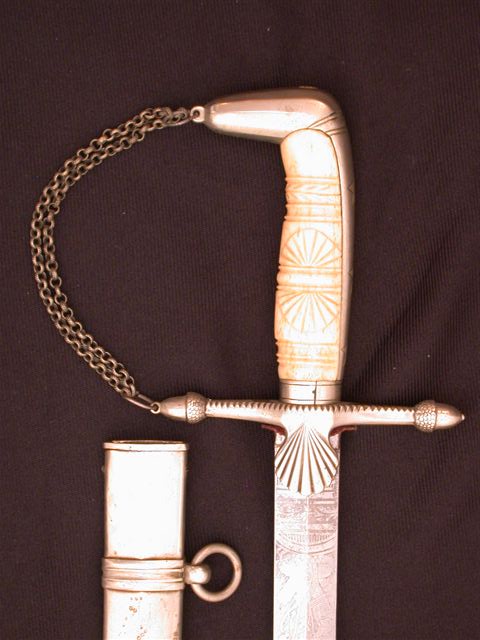
 Attachment: 49.49 KB Attachment: 49.49 KB
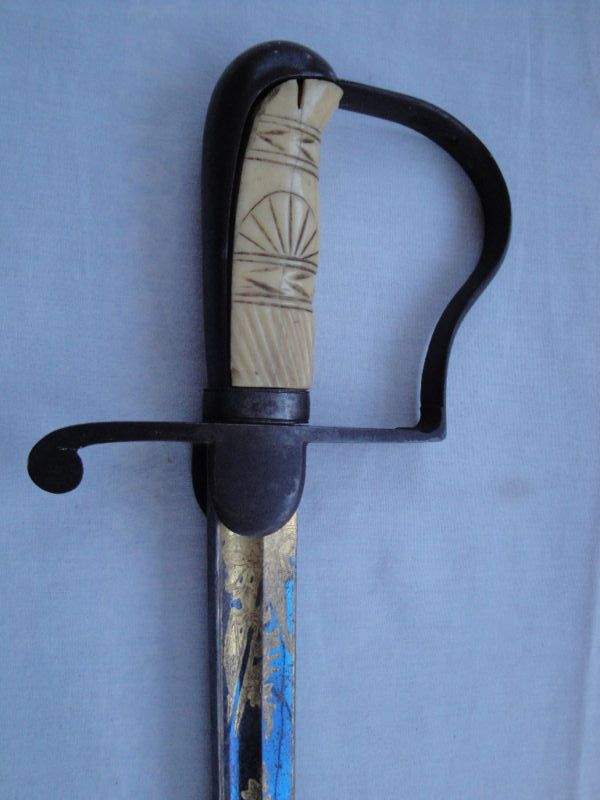
 Attachment: 45.29 KB Attachment: 45.29 KB
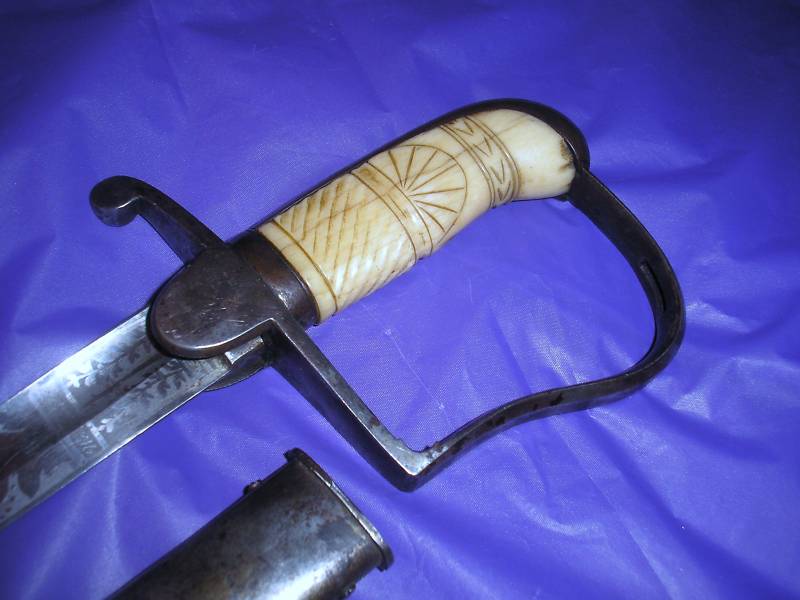
 Attachment: 36.9 KB Attachment: 36.9 KB
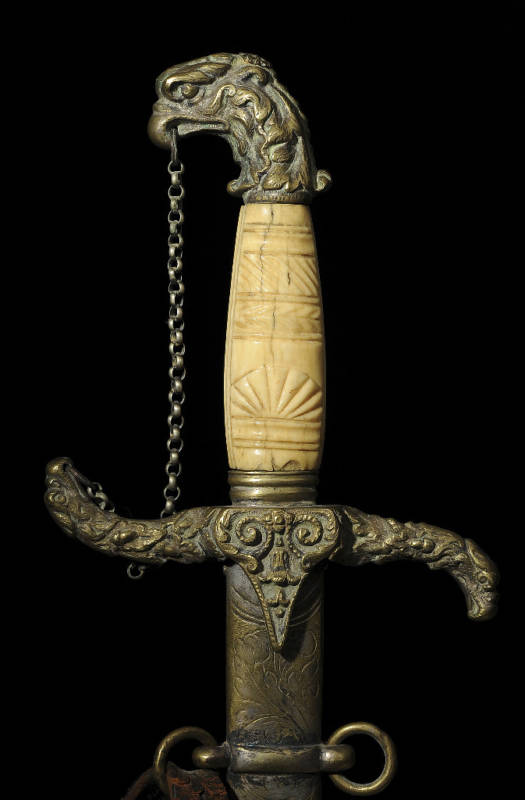
 Attachment: 54.66 KB Attachment: 54.66 KB

 Attachment: 22.79 KB Attachment: 22.79 KB
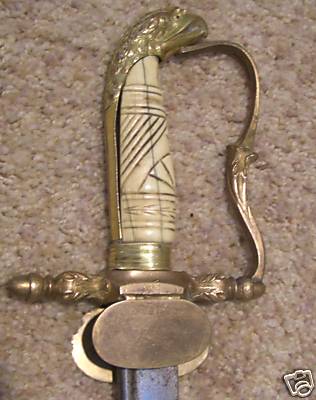
 Attachment: 12.33 KB Attachment: 12.33 KB
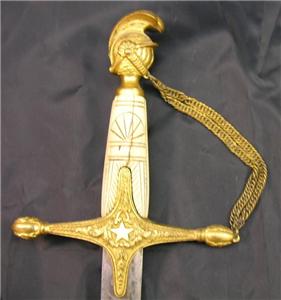
 Attachment: 238.92 KB Attachment: 238.92 KB
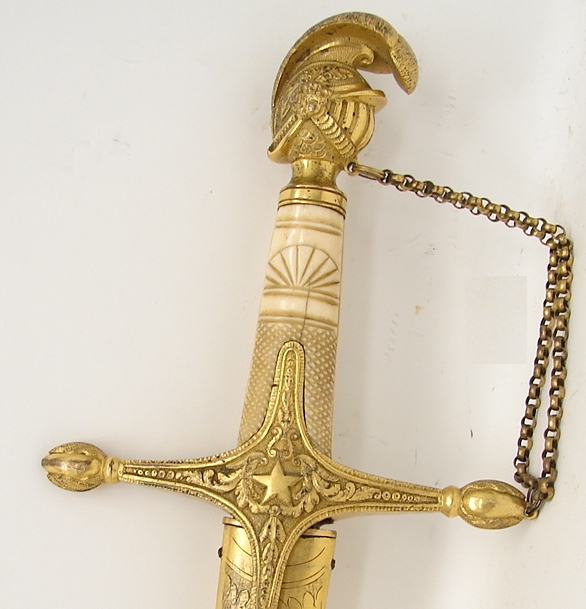
|
|
  |
 |
Glen A Cleeton

|
 Posted: Sat 03 Sep, 2011 6:33 pm Post subject: Posted: Sat 03 Sep, 2011 6:33 pm Post subject: |
 |
|
A couple of more. The number of them even in variation endless. This last dove head sabre marked by Spies in New York City. The eagle a new friend and the pistol grip one I wish I had saved better shots of in profile.
Cheers
GC
 Attachment: 81.43 KB Attachment: 81.43 KB
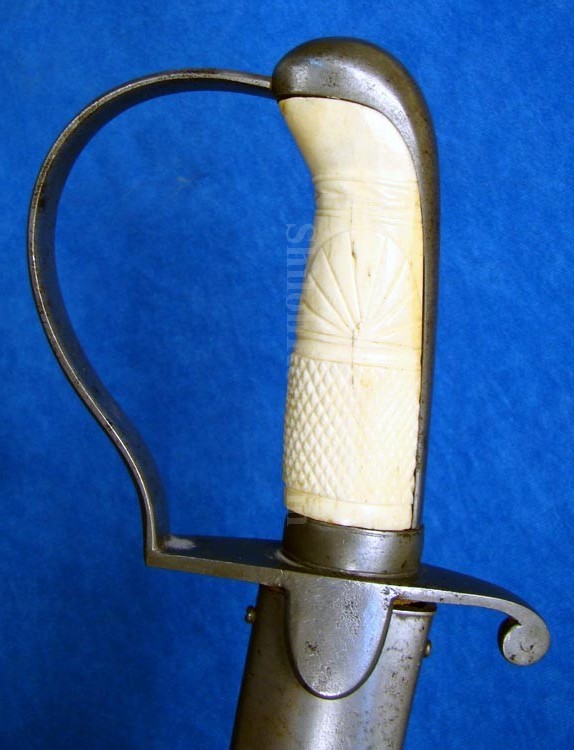
 Attachment: 75.58 KB Attachment: 75.58 KB
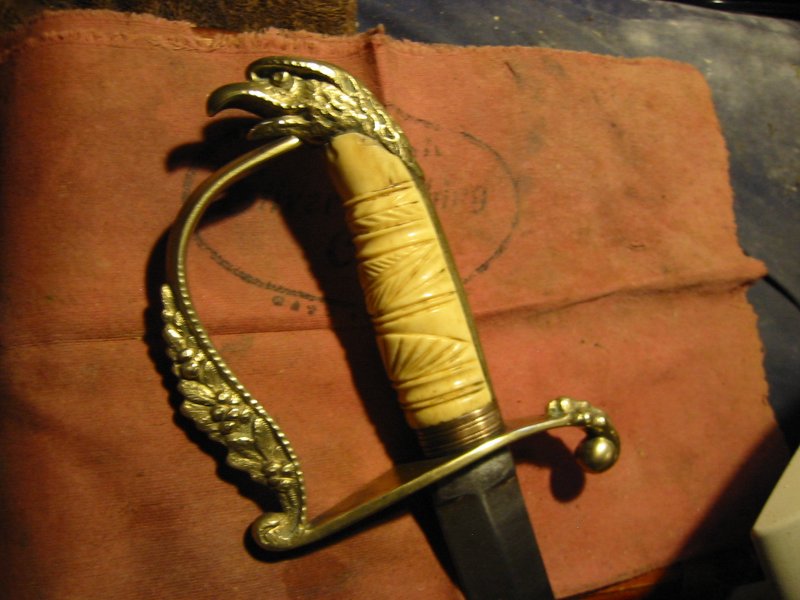
 Attachment: 31.29 KB Attachment: 31.29 KB
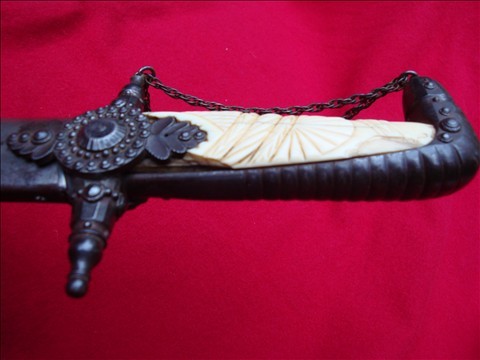
|
|
  |
 |
|
William P
|
 Posted: Mon 05 Sep, 2011 7:02 pm Post subject: Posted: Mon 05 Sep, 2011 7:02 pm Post subject: |
 |
|
| Norman McCormick wrote: | A couple of Tulwars early to mid 19thC, very sharp as are most antique Indian weapons. The use of wooden scabbards covered in hide or cloth contributed to these blades usually being in a better state of readiness for use i.e. sharpness than their European counterparts which were dulled by being sheathed and unsheathed from metal scabbards.
Regards,
Norman. |
this might explain a great deal why richard sharpe is constantly resharpening his sword, i think he resharpens it at least once per book, and in some books twice.
the sharpe series costantly speakes of the sword scraping out of thescaabbard, now i realise a novel is a novel, bt therewould be something to this idea of scraping noises made when drawing blades and needing to resharpen them decently often.
|
|
   |
 |
|
Jonathan Hopkins
|
 Posted: Fri 09 Sep, 2011 10:27 am Post subject: Posted: Fri 09 Sep, 2011 10:27 am Post subject: |
 |
|
I think I have exhausted the 19th century swords still in my collection, but I do have a few photos of swords I have sold over the years. I'll start with the non-British swords.
First, an Italian M1860 cavalry trooper's sword marked S&K for Schnitzler & Kirschbaum, c.1860-64. It is a huge sword and I am eager to find another one some day.



A US M1860 cutlass, which ended up being a very good, and older (1960s?), replica. You live and learn. I bought it when I was 15 and had done no research ahead of time.



The remains of a French M1837 infantry officer's epee marked Coulaux Freres de Klingenthal. Was it broken in battle or play--who knows? It was found in a musty basement in near Milwaukee, Wisconsin. This one I still own.



Last edited by Jonathan Hopkins on Sun 11 Sep, 2011 8:05 am; edited 1 time in total
|
|
  |
 |
|
Michal Spilka
Industry Professional
Location: Czech republic Joined: 06 Mar 2011
Posts: 89
|
 Posted: Sat 10 Sep, 2011 12:05 pm Post subject: Posted: Sat 10 Sep, 2011 12:05 pm Post subject: |
 |
|
Hi,
I´ve got similar smallsword from my grandfather, made in St. Etiene.
M.
 Attachment: 42.99 KB Attachment: 42.99 KB
[ Download ]
 Attachment: 84.33 KB Attachment: 84.33 KB
[ Download ]
 Attachment: 78.47 KB Attachment: 78.47 KB
[ Download ]
Michal Spilka
Nielo - Sword
|
|
    |
 |
|
Jonathan Hopkins
|
 Posted: Sun 11 Sep, 2011 7:42 am Post subject: Posted: Sun 11 Sep, 2011 7:42 am Post subject: |
 |
|
Michal,
Thanks for posting your grandfather's sword! The symbolism on the guard of your sword has me stumped--not hard to do since I don't know much about French swords. However, as I looked into similar French models trying to find one similar to yours I realized I had misidentified my own sword hilt. I think it is more likely a Model 1852 Superior Officer's Sword (based on the information available at OldSwords.com). The M1837 pictured at OldSwords has a fish skin grip and different motifs on the guard and pommel. The M1852's motifs match those on my own, as does the polished horn grip.
Perhaps a posting a query in the Antique & Military Sword section at SwordForum.com will result in a positive identification.
Jonathan
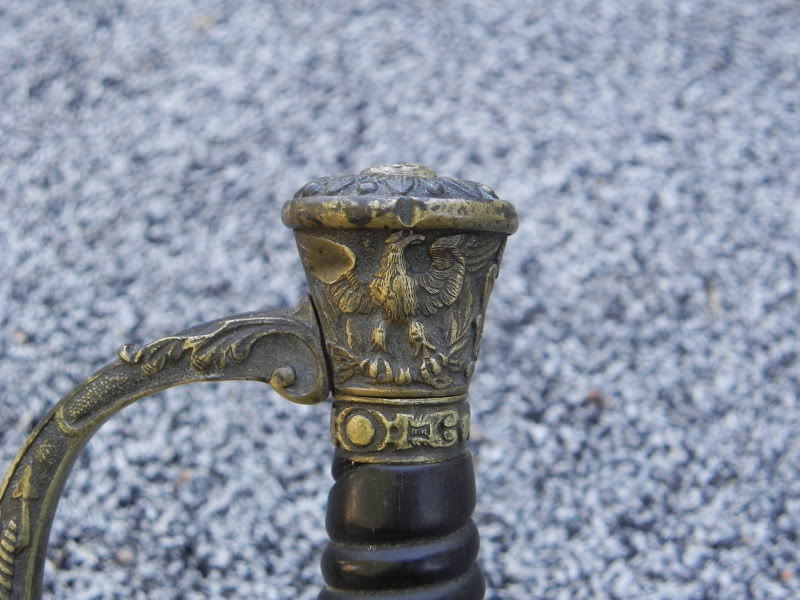
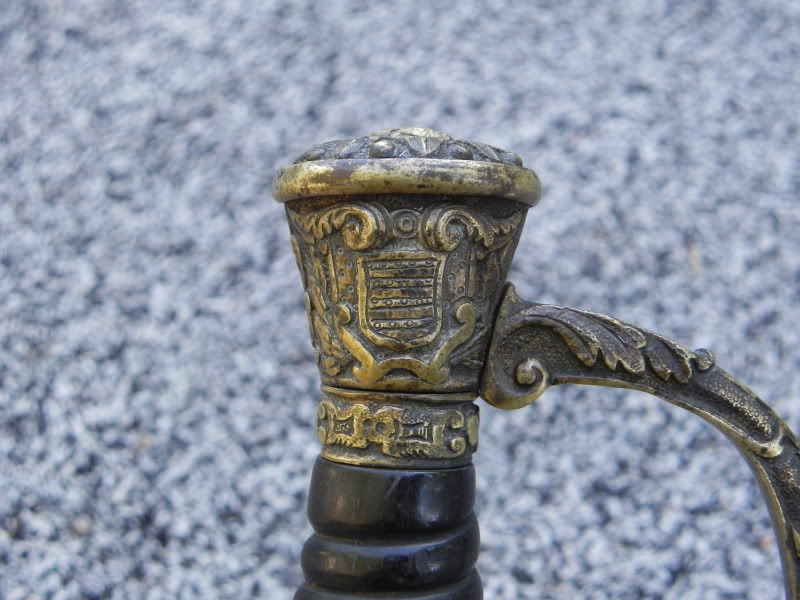
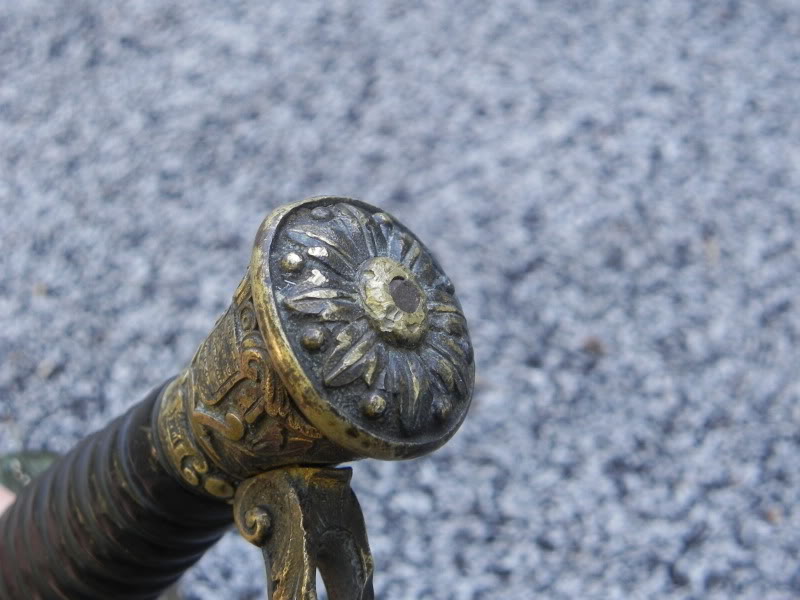
|
|
  |
 |
|
Michal Spilka
Industry Professional
Location: Czech republic Joined: 06 Mar 2011
Posts: 89
|
 Posted: Mon 12 Sep, 2011 11:28 am Post subject: Posted: Mon 12 Sep, 2011 11:28 am Post subject: |
 |
|
Hi,
I have to say I´m on very bad level with knowledge of french weapons.
I´m interested more in Prussia and Austria 18th Century.
I saw the same smallsword in Musee de l´Armee in Paris. Unfurtunately photos didn´t come out well, because of a bad light in the museum. There were silver stars on the eagle, I think it might be rank sign, but I´m not sure.
M.
Michal Spilka
Nielo - Sword
|
|
    |
 |
|
Jonathan Hopkins
|
 Posted: Mon 16 Jan, 2012 7:09 pm Post subject: Posted: Mon 16 Jan, 2012 7:09 pm Post subject: |
 |
|
This is another one I regret selling--a French M1829 artillery trooper's saber. The US copied this model and it is known as the M1840 light artillery saber.


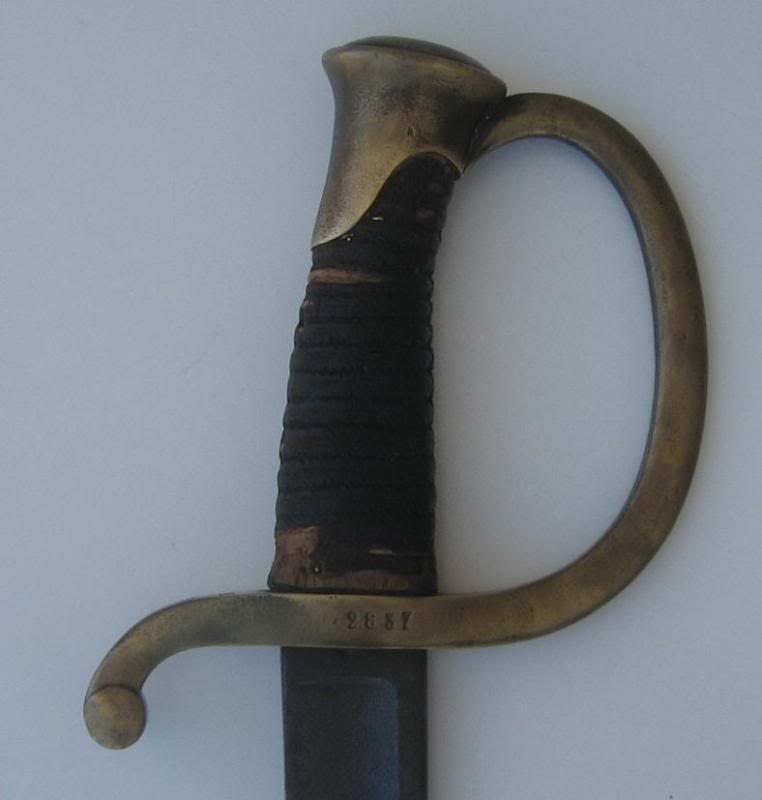
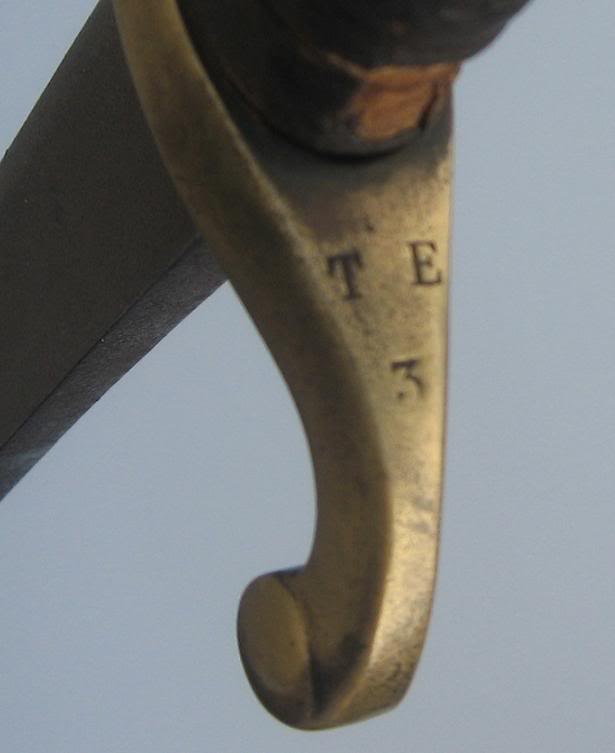
|
|
  |
 |
|
|
You cannot post new topics in this forum
You cannot reply to topics in this forum
You cannot edit your posts in this forum
You cannot delete your posts in this forum
You cannot vote in polls in this forum
You cannot attach files in this forum
You can download files in this forum
|
All contents © Copyright 2003-2024 myArmoury.com — All rights reserved
Discussion forums powered by phpBB © The phpBB Group
Switch to the Basic Low-bandwidth Version of the forum
|

